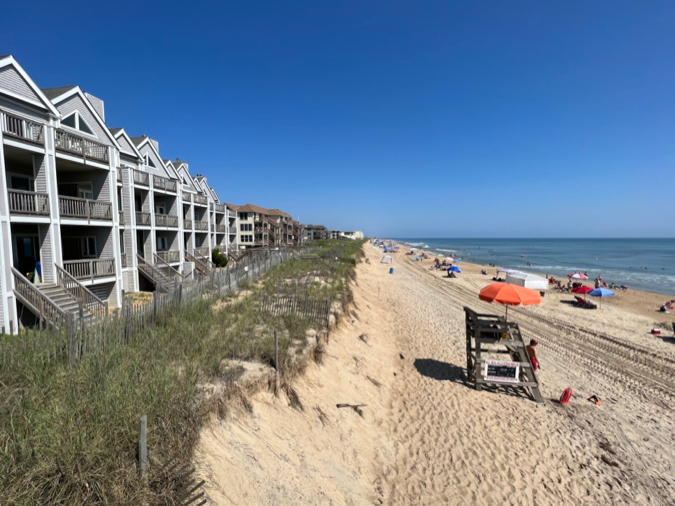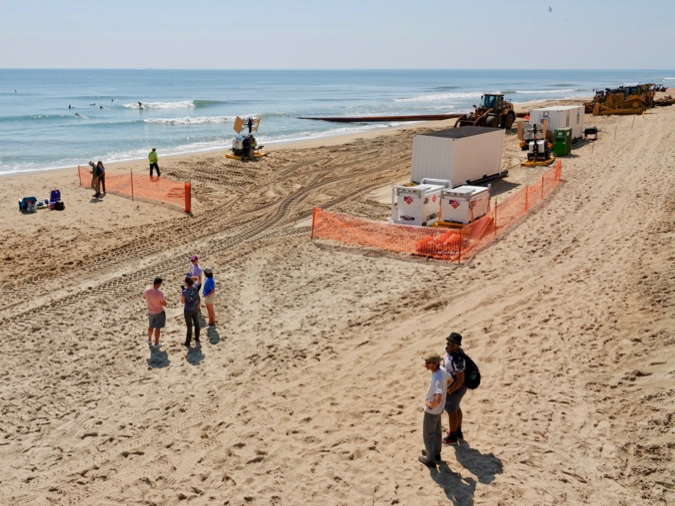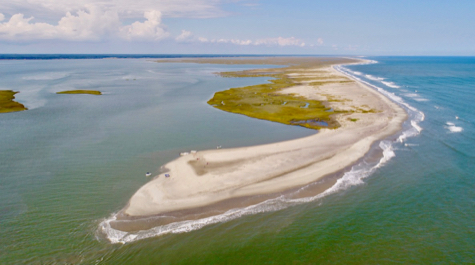Study predicts faster retreat of barrier islands
New model shows lag in islands’ response to accelerating sea-level rise
Barrier islands respond to rising seas by retreating landward, diminishing their capacity to protect the coastline—and beachfront property—from storm surge, waves, and flooding. But a study in today’s Nature Geoscience shows that rise and retreat aren’t always synchronous, and predicts a 50-percent acceleration in the rate of barrier-island retreat within a century, even in the unlikely case of no further increase in the present rate of sea-level rise.
 “These findings can be applied all over the world, but are particularly significant in the U.S., where houses are being built extremely close to the beach,” says lead author Dr. Giulio Mariotti, associate professor at Louisiana State University.
“These findings can be applied all over the world, but are particularly significant in the U.S., where houses are being built extremely close to the beach,” says lead author Dr. Giulio Mariotti, associate professor at Louisiana State University.
Mariotti and his co-author, Dr. Christopher Hein of William & Mary’s Virginia Institute of Marine Science, undertook the study to help explain why barrier-island retreat has lagged behind the dramatic acceleration in global sea-level rise observed during the past half century. The study rests on a model Mariotti developed using data collected by Hein and others from the barrier islands along Virginia’s coast. The islands’ pristine nature freed the researchers from complications introduced by beach nourishment and shoreline hardening, factors that affect coastal dynamics in many other settings.
“It’s well known that barrier islands retreat as sea level rises, but it hasn’t been clear how,” says Mariotti. “Our model shows the modern rate of barrier-island retreat isn’t controlled by the last few decades of acceleration in sea-level rise, but by baseline rates of sea-level rise across the past few millennia.” Evidence from geology and tide gauges shows a baseline rate of about 1 millimeter of global sea-level rise per year during the last 5,000 years has tripled to a rate of ~ 3 mm/yr during the last 50-100 years. Equivalent values from the Virginia barrier islands, a sea-level "hotspot," are 1.5 and 4.5 mm/yr.

“The cumulative effect of the baseline sea-level rise,” says Hein, “was to build up a vast reservoir of sand and mud across the barrier-island system.” When sea-level rise began to accelerate in the early 1900s, the potential for retreat was first realized through removal of this “geomorphic capital” offshore by storms and tides. The islands are now free to retreat landward in proportion to today’s accelerated rise rates. “It’s like a home loan,” says Hein. “You have to spend years and years paying off the interest before you start to see a rapid reduction in your principal.”
“One of the most original parts of the model,” says Mariotti, “is it can run simulations over thousands of years but can also provide insights into decades, which is more interesting for management.” “At the same time,” he adds, “I can also run simulations over centuries and millennia, which allows the results to be compared with geologic data.”
“One reason previous models didn’t see the lag,” he adds, “was because they assumed the geometry of the whole coastal tract—from the lower continental shelf to the upland boundary, including subaerial barriers, inlets and tidal channels—was frozen. However, the geometry can change and that’s what’s enabling this lag effect.”
The model predicts that retreat of the Virginia barrier islands will increase from its current rate of ~ 5 meters per year to almost 7 meters per year by 2100, a nearly 50% increase. If the rate of sea-level rise increases—which is likely according to the latest U.N. climate report—barrier-island retreat may increase even more. It’s important to note these predictions do not account for any increase in the frequency or strength of coastal storms, which can also exacerbate barrier-island retreat.
{{youtube:large|2snmuFSPPcs, Cedar Island is 1 of 12 major barrier islands along Virginia's Atlantic coast. Its annual rate of retreat—already rapid at 6.6 meters per year—is predicted to accelerate by up to 50% by 2100 as the Virginia barrier island system re-equilibrates to the rapid acceleration in sea level experienced over the last 50-100 years. Animation created from Google Earth Engine.}}
Hein notes that “because the Virginia Barrier Islands are almost entirely undeveloped, they are among the most dynamic in the world. This study shows that what we are seeing out there today is only a hint of what’s to come given increasing rates of sea-level rise; and what is likely in store for developed islands globally in the absence of ever-accelerating beach nourishment and hardening.”
Mariotti notes that barrier islands vary and although his model predicts an increase in retreat for relatively undeveloped barrier islands like those off Virginia, other barrier islands around the world may retreat faster, slower, or even move away from the shore depending on changes in river runoff and coastal-protection measures such as beach nourishment and shoreline hardening.
| Mariotti, G., Hein, C.J. Lag in response of coastal barrier-island retreat to sea-level rise. Nat. Geosci. (2022). https://doi.org/10.1038/s41561-022-00980-9 |


